"Anyway, let's zoom out and examine the same pattern in the context of a business. A business has a Markov blanket. All the different facets of the business — the employees, clients, resources, products, marketing strategies, hardware, software, office space, etc. — are Markov blanketed 'things' nested within that business. These nested sub-systems are equivalent to the cells and organs in a human body.
The market also has its own Markov blanket; a mathematical model of itself. Let's pretend the market is square-shaped. Four businesses exist within this particular market: Business A, Business B, Business C, and Business D. We're going to look at this from Business A's perspective, so I've made Business A white. The grey area represents what Business A is observing."

"The black area represents surprise in the system. There is a gap between Who The Businesses Are, and Who The Market Is. Because the system is designed to minimize surprise, that gap will be filled in two ways. Either a new business will form, or an existing business will change its shape (i.e. Who It Is) to minimize the surprise."
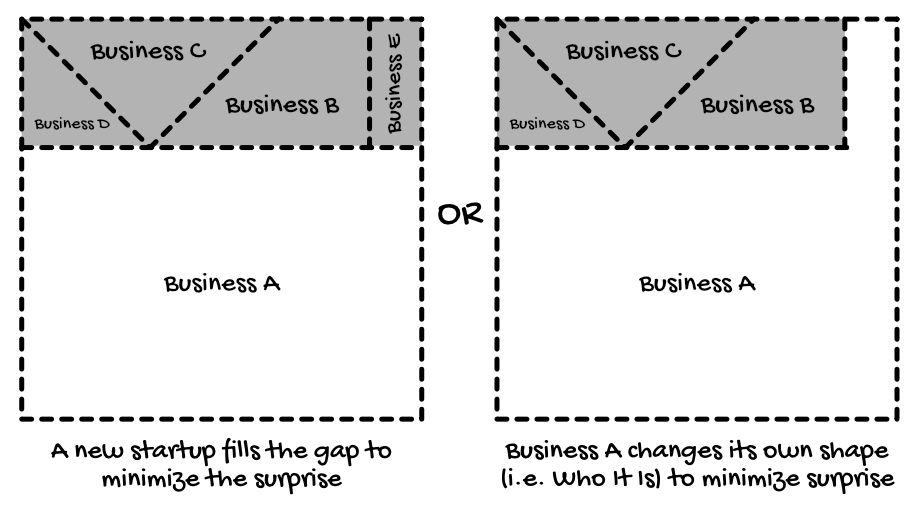
"Currently, this market is in perfect homeostasis because there is no longer any surprise in the system. But let's assume the market changes to a circle shape."
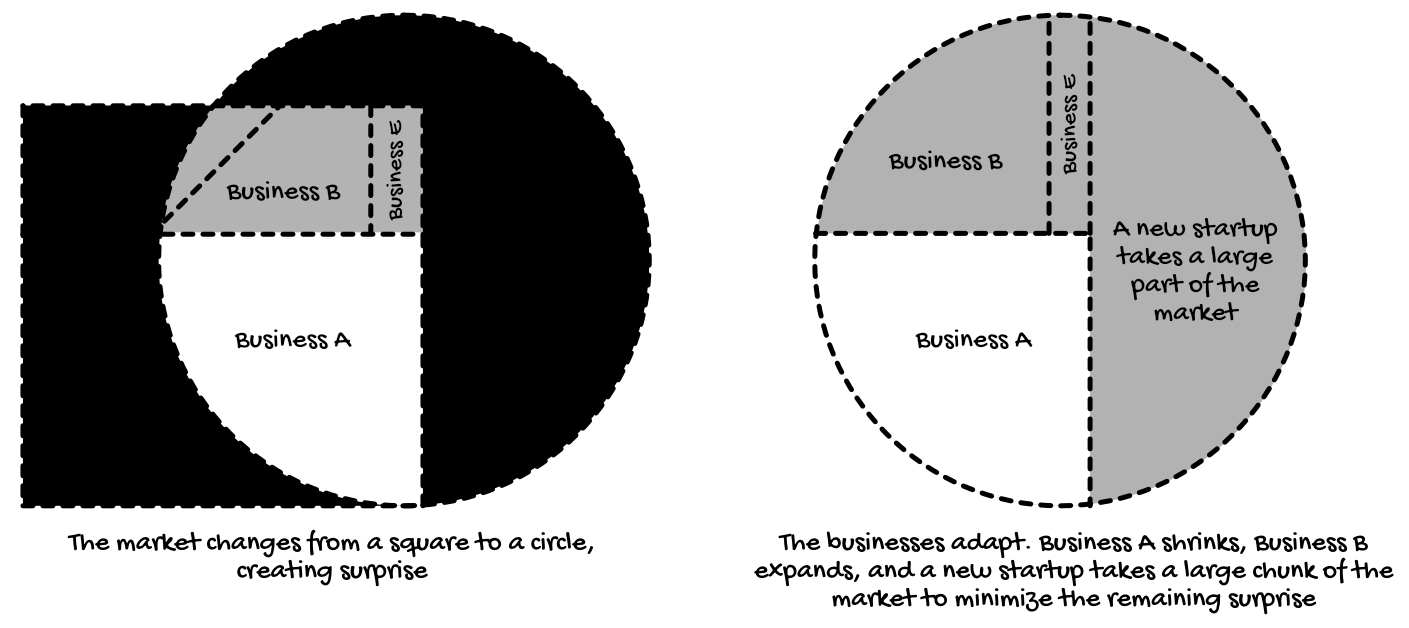
"Some businesses, like Business D, won't survive. Business D is the equivalent of a human body with a 45-degree temperature, when a homeostatic temperature is 37 degrees. Because the business exists in such a surprising high-entropy state, it will probably die — just like a human body will die if it ventures too far away from 37 degrees. All of the businesses' resources will disband and be recycled into other creations.
Other businesses, like Business A, must adapt to take the new shape of the market. In general, the bigger the business, the harder that is to do. That's why Business A will probably lose market share. It can't reshape itself fast enough to match the changing market.
This explains why small, nimble startups can rapidly overtake old, calcified companies. It's difficult to rearrange a large company into a new shape. You constantly need information flowing into the company that says, 'Hey, we're venturing into a high-entropy state.' The leader needs to communicate a very clear vision of Who The Company Is. This allows the entities inside the company to rearrange into the specific, low-entropy shape that matches the market. Without strong leadership, focus, and market insight, a business will eventually morph into a very non-specific shape and die."
"So, it's like Blue Ocean Strategy?"
"That rings a bell. Where do I know that from?" I asked.
"It's that business book that was really popular a few years ago. Hold on…" He began reading from their website.
WHAT IS BLUE OCEAN STRATEGY?
Blue ocean strategy is the simultaneous pursuit of differentiation and low cost to open up a new market space and create new demand. It is about creating and capturing uncontested market space, thereby making the competition irrelevant. It is based on the view that market boundaries and industry structure are not a given and can be reconstructed by the actions and beliefs of industry players.
"There!" I said. "'Market boundaries and industry structure are not a given and can be reconstructed by the actions and beliefs of industry players.' God talks about the same pattern here…"
You exist in this life in the world of the relative, where one thing can exist only insofar as it relates to another. This is at one and the same time both the function and the purpose of relationship: to provide a field of experience within which you find yourself, define yourself, and — if you choose — constantly recreate Who You Are. [...] Thought, word, and deed are the three levels of creation.
Neale Donald Walsch
I continued. "Market boundaries are just Markov blankets. The 'shape' of these markets can be reconstructed by the 'actions and beliefs of industry players' — just like the 'shape' of these Markov-blanketed souls can be reconstructed from 'thought, word, and deed.' God says the same thing as this book. It's a holographic pattern. Keep reading."
Zac continued.
WHAT ARE RED OCEANS AND BLUE OCEANS?
In their classic book, Blue Ocean Strategy, W. Chan Kim and Renée Mauborgne coined the terms ’red ocean’ and ‘blue ocean’ to describe the market universe.
Red oceans are all the industries in existence today — the known market space. In red oceans, industry boundaries are defined and accepted, and the competitive rules of the game are known.
Here, companies try to outperform their rivals to grab a greater share of existing demand. As the market space gets crowded, profits and growth are reduced. Products become commodities, leading to cutthroat or ‘bloody’ competition. Hence the term red oceans.
Blue oceans, in contrast, denote all the industries not in existence today — the unknown market space, untainted by competition. In blue oceans, demand is created rather than fought over. There is ample opportunity for growth that is both profitable and rapid.
In blue oceans, competition is irrelevant because the rules of the game are waiting to be set. A blue ocean is an analogy to describe the wider, deeper potential to be found in unexplored market space. A blue ocean is vast, deep, and powerful in terms of profitable growth.
"There are several things to note here," I said. "Firstly, Peter Thiel makes the same point in his book, Zero to One. Artists go from zero to one, thereby creating new 'blue ocean' markets that didn't exist before. They say, 'In blue oceans, competition is irrelevant because the rules of the game are waiting to be set.' This is the same sentiment that God expresses when he talks about pure creation…"
Such a choice — a decision coming from no previous personal knowledge — is called pure creation. And the individual is aware, deeply aware, that in the making of such decisions is the Self created.
Most of you are not interested in such important work. Most of you would rather leave that to others. And so most of you are not self-created, but creatures of habit — other-created creatures.
Neale Donald Walsch
"Creation, by definition, involves going from zero to one. It's easy to look at what everyone else is doing and copy it, but that's not creation. That's science, not art. Art creates new blue ocean markets. Science studies what already exists in red oceans, and makes it incrementally better. I'll illustrate this with our stencil analogy."
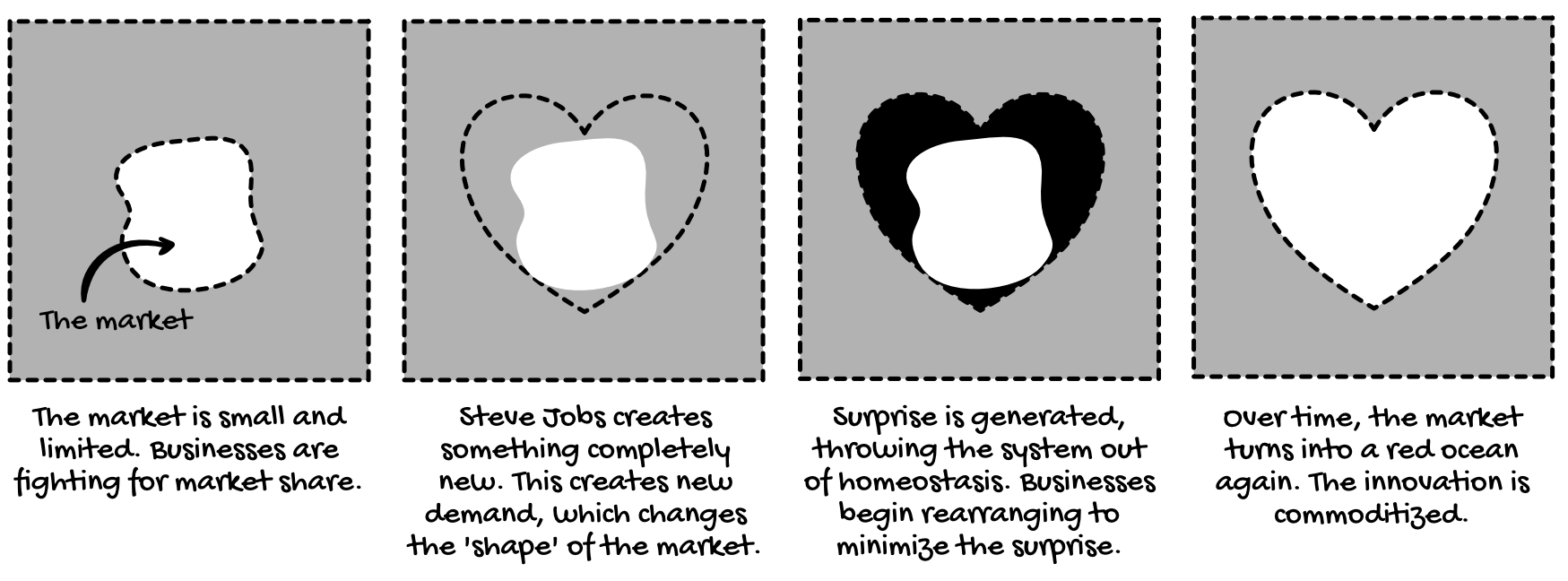
"Let's say the market for mobile phones in the early 2000s is saturated. It's a red ocean. Then Steve Jobs comes along and engages in an act of pure creation. He doesn't copy what everyone else is doing. That would make him an 'other-created creature,' as God calls it. Instead, he creates the first smartphone, completely from scratch.
When he shares this innovative new vision for the future with society, everyone wants a smartphone. This desire creates surprise in the system, which must be minimized. Over time, the smartphone market turns into a red ocean again as businesses compete to commoditize and globalize the innovation. At this point, the only way to expand the market is to create more surprise again. The only way to create surprise is to go from zero to one. Do you see the pattern?"
"Yeah," Zac said.
"This diagram illustrates the difference between red ocean markets and blue ocean markets. In the red ocean market, businesses are fighting over scraps of surprise. They're jostling and competing with each other to fill the tiny gaps in the market and steal market share, but they aren't making the market bigger. Artists, on the other hand, create entirely new blue ocean markets that are filled with pure surprise. Therefore, scientists compete over a limited-sized pie, whereas artists bake more pie.
Of course, this is just basic economics. GDP growth comes from innovation. Innovation, by definition, involves creating something new. New things generate surprise in the system. The system minimizes that surprise over time, commoditizing the innovation. Therefore, the only way to grow the pie for everyone is to innovate. If our society doesn't innovate, we'll always be fighting over incremental scraps of surprise. When those scraps disappear, we'll fight with each other."
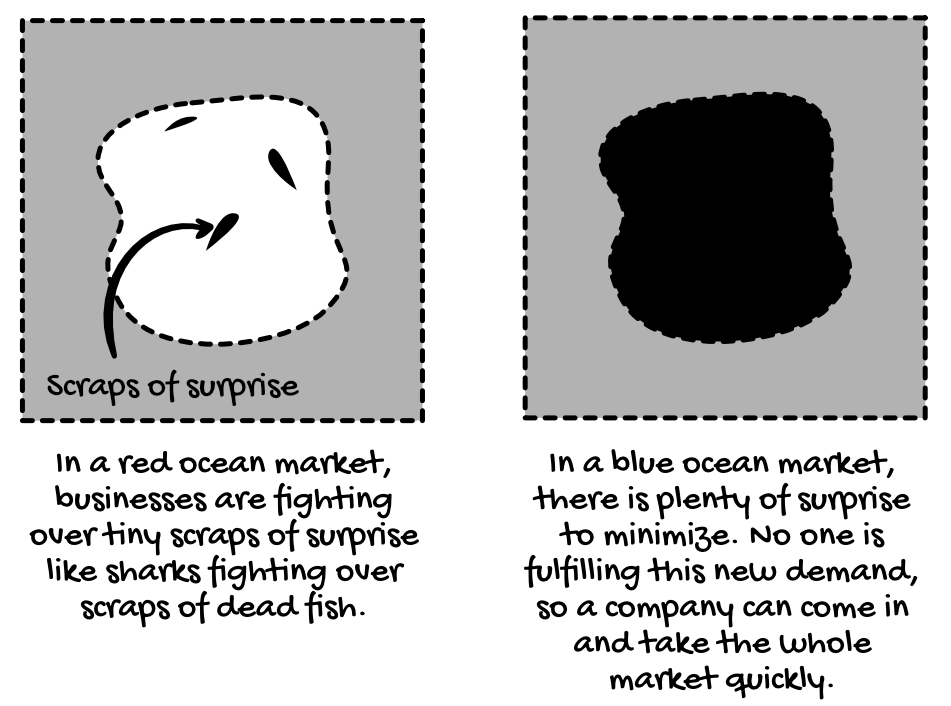
"In my opinion, this simple idea illustrates where our society has gone so wrong. We have built a society geared towards producing scientists, not artists. We fucking love order and efficiency, so we're incredibly efficient at competing and fighting over limited resources instead of creating new resources and opportunities from thin air. Our education system teaches kids how to regurgitate facts and tick boxes and compete for marks. If a child doesn't want to play by those rules, we label them 'broken' and put them on some ADHD medication. It's fucked up. If we create a society of rule-followers, we'll forever be fighting over the scraps of a small pie. Instead, we should be teaching kids how to bake more delicious pie that can benefit everyone. We have rule-breaking artists and chaotic, inefficient troublemakers to thank for our current quality of life. Yet, our entire society is optimized to stamp the creativity out of these people and get them to fall in line and be good drones. If we keep optimizing for efficiency over creativity, society will eventually stagnate, decline, and then go to shit as we squabble over the little resources that are left. Just watch. It's not going to be pretty. It's already starting to happen.
Now, I want to point out one more pattern before we move on. You said, 'In their classic book, Blue Ocean Strategy, W. Chan Kim & Renée Mauborgne coined the terms 'red ocean' and 'blue ocean' to describe the market universe.' I want you to take that idea literally. These businesses literally follow the same holographic pattern as the entire universe.
Remember our whirlpool model that characterized planets and black holes and 'particular' things in the universe as whirlpools? The stronger the whirlpool, the more powerful and attractive it becomes. If you fly your rocket ship near a black hole, you'll be sucked in and crushed by its gravitational pull. To escape its gravitational pull, you'll need to expend a lot of energy fighting that natural momentum."
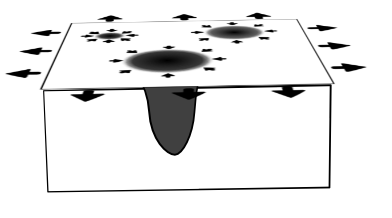
"Well, it's the same holographic pattern playing out in the 'market universe.' Powerful, established businesses attract money, resources, clients, and other forms of 'energy,' just like a black hole attracts spaceships and meteors in its vicinity. If you start a new business within the vicinity of a metaphorical 'black hole' and attempt to compete with them head-on, you'll be crushed by their momentum. At the very least, you'll expend a lot of energy escaping their gravitational pull.
On the other hand, if you build your business in an unoccupied area of the universe, you can do your thing without constantly fighting against the momentum of other things around you. Over time, if you're skilled, your business might even turn into a black hole — a monopoly. It will suck in other businesses around it. Your momentum will prevent competitors from getting a foothold in your market space.
Whether it's a literal black hole in the cosmos or a metaphorical black hole in the economy, the same algorithmic optimization is at play. Everything is minimizing surprise."

